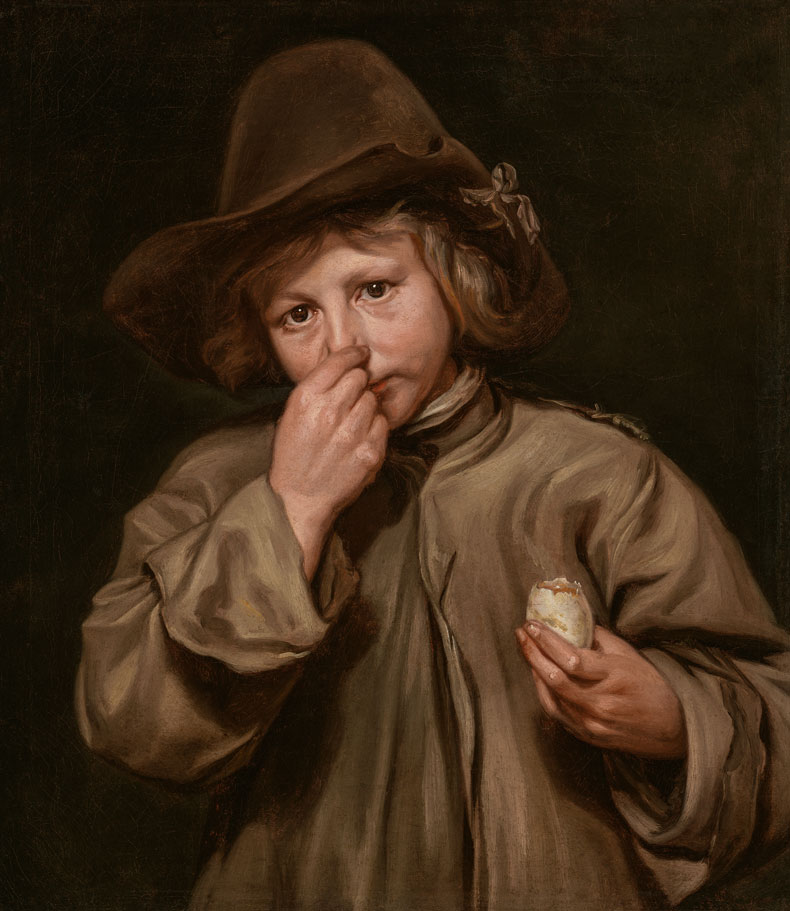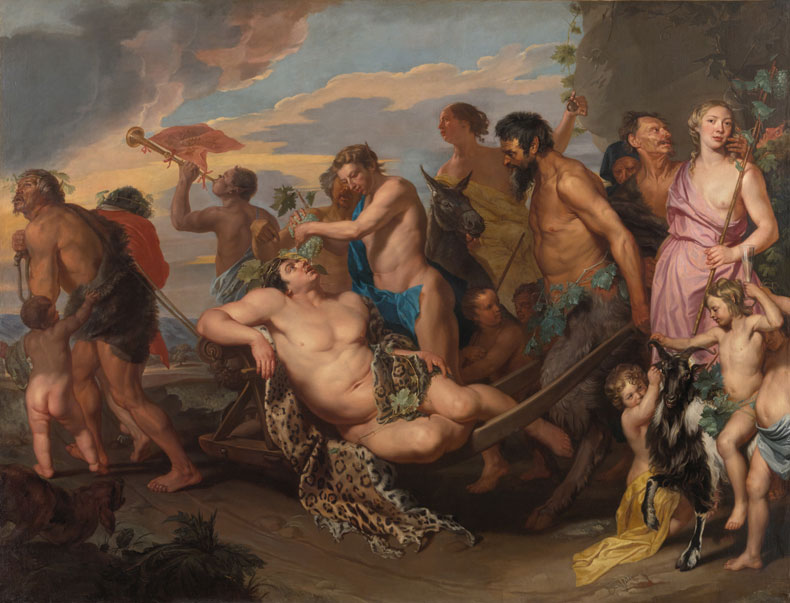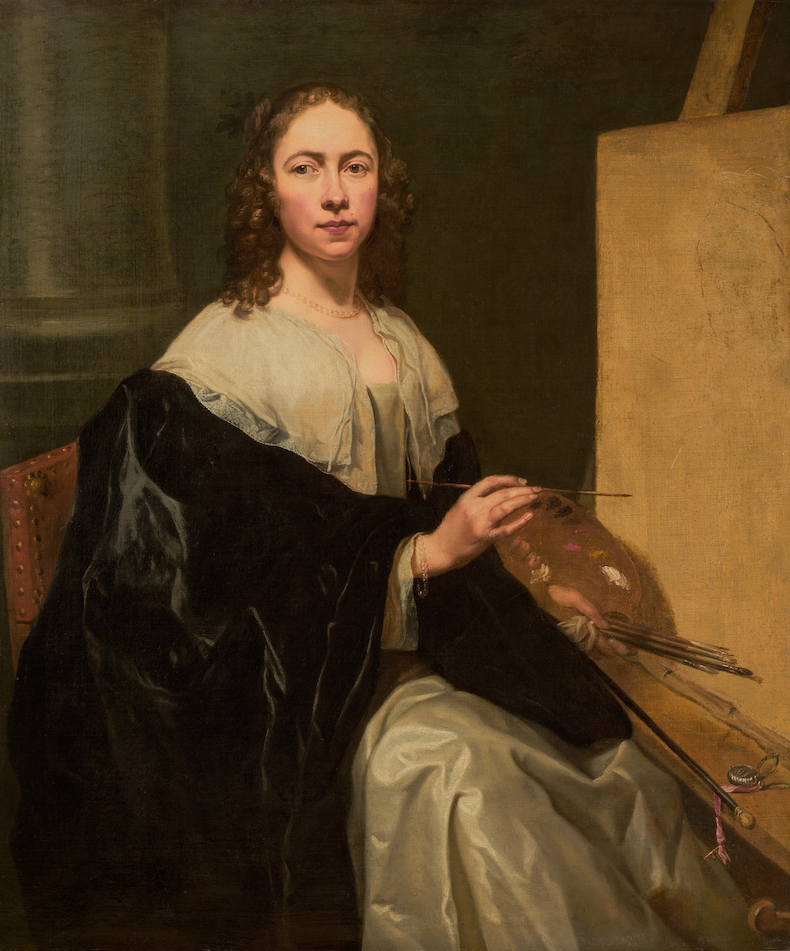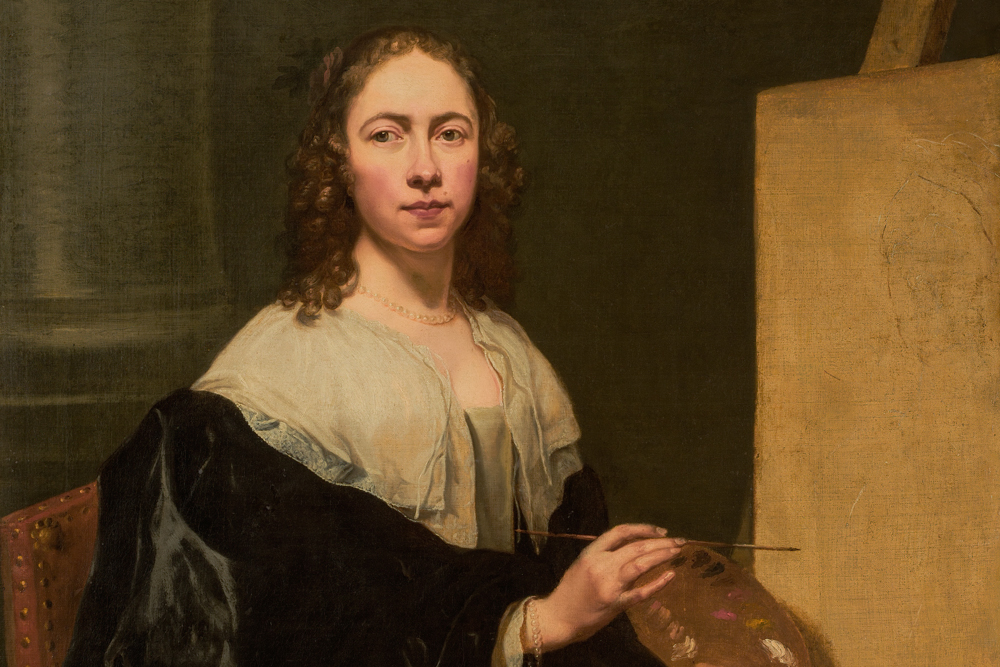From the November 2025 issue of Apollo. Preview and subscribe here.
Hold your nose. Something smells. A rotten egg. You can almost see the foul vapour rising from the shell. A boy pinches his nostrils, concealing his mouth, and meets our gaze with an inscrutable stare. The paintings comprising Michaelina Wautier’s philosophical reflection The Five Senses (1650) certainly have a mischievous quality. In another, a knife rests on a table, blood drips from a boy’s hand, his strange face contorted in an expression of pain and annoyance. A boy tries to play his recorder but is distracted; another takes a sly bite of buttered bread. One last boy holds a pair of glasses to his eyes, peering inquisitively at the palm of his hand. These five witty, masterfully painted works resurfaced from a private collection only in 2020. Signed and dated by Wautier, they cement her newly established reputation as one of the most significant female painters in the history of art.
The ‘rediscovery’ of Wautier and the impressive reconstruction of her career by the art historian Katlijne Van der Stighelen over the last 30 years have reached their culmination in an exhibition at the Kunsthistorisches Museum in Vienna, which travels to the Royal Academy in London next spring. Why an artist of such outstanding talent and originality should have been ignored for more than three centuries is obvious – because she was a woman. What is more surprising, perhaps, is despite feminist scholarship confronting patriarchal biases since the 1970s, a great painter like Wautier, with works in world-famous museums, should have continued to go unnoticed. Nevertheless, after a landmark exhibition in Antwerp in 2018 and now this more complete show in Vienna, there can be no doubt about Michaelina Wautier’s status as a great artist.

Probably born around 1614 in Mons, in modern-day Belgium, very little of Wautier’s life is documented. She came from a large, wealthy, intellectually well-connected family. Her brother Charles was also a painter. The siblings lived together and likely shared a studio in Brussels. Neither married. Michaelina’s first dated work is a portrait known from a print of 1643, her last an Annunciation from 1659. She lived for another 28 years, dying in her early to mid seventies.
The paintings are those of a skilful, ambitious and varied artist; this exhibition has examples of almost every genre: portraits, still life, history paintings. We find a persistent and surprising corporeal quality, especially in the sensual rendering of skin. Wautier is fascinated by figures of various ages, from little boys, to mature men, to old women. These are bought into close proximity in the colourful Education of the Virgin (1656), which contrasts the tender yet furrowed face of Saint Anne with the youthful bloom of Mary. Dirty fingernails in the Boys Blowing Bubbles (c. 1650–55), translucent wings and feathery petals in the Flower Garland with a Dragonfly (1652), a hairy waterskin in Portrait of a Man as the Biblical Jacob (c. 1655). All around are physical, sensual surfaces. This quality extends to the surface of the paintings themselves with their variety of brushwork and finish, which is at times fluid, choppy, layered. Yet there also seems to be an emotional and intellectual depth which we are only just beginning to fathom.
Despite the exhibition’s title, there are in fact two artists on display. Charles Wautier was a professional portrait painter, who also produced religious narratives and large-scale altarpieces. He may not have had the natural talent of his sister, but he was an accomplished and successful artist as seen in the nine paintings and 10 prints on display here. Charles was four years older than Michaelina and his earliest dated work is from 1650, the year before he joined the painters’ guild in Brussels. The exact relationship between their work is difficult to define, although there are similarities in their style, materials and working methods. The exhibition suggests that Michaelina’s hand can be detected in both The Calling of Saint Matthew (c. 1655–65) and Christ Among the Doctors (c. 1650–65).

The Kunsthistorisches Museum’s own The Triumph of Bacchus (c. 1655–59) is held up as Michaelina Wautier’s masterpiece and was the painting that first inspired Van der Stighelen’s quest to uncover the artist. A spectacular exercise in variations of the male nude, it is an intensification of the variety and corporeality seen throughout Wautier’s oeuvre: a unique achievement at a time when women were forbidden from studying nudes.
The Bacchus appears in the 1659 inventory of the famous collection of Archduke Leopold Wilhelm of Austria, governor of the Spanish Netherlands in this period, where it is attributed to ‘N. Woutiers’. Causing more confusion, three other paintings belonging to the archduke are listed as by ‘Magdalena Woutiers’ – the name of Michaelina’s sister. In 1967 the curator Günther Heinz first argued that all four were by Michaelina, but the paintings and their author continued to be ignored. Strangely, the Bacchus is not signed by Michaelina and there are parallels between some figures and a Young Bacchus by Charles in the National Gallery, Prague (not exhibited). Even so, during a workshop in 2024, experts reached the conclusion that The Triumph of Bacchus is entirely the work of Michaelina.

The exhibition features some disappointing works, however, including a Mystic Marriage of Saint Catherine (signed and dated 1649), which, despite restoration, is still in poor condition. Because of works by Michaelina herself being very limited in number, they are augmented by some more or less successful comparisons with paintings by other artists, including Anthony van Dyck. Her extraordinary, psychologically intense portrait of the Jesuit missionary Martino Martini (1654), who had recently returned from 10 years in China, is displayed alongside historical examples of the Chinese costume he wears.
Most compelling of all is Wautier’s powerful and challenging self-portrait (c. 1650). Sat majestically at her easel, she has started to sketch a figure on the canvas. In a type of negative illusion, the ground has been left uncovered, meaning we look at the canvas of the picture itself; there is so much more to learn about Michaelina Wautier and her art.
‘Michaeline Wautier: Painter’ is at the Kunsthistorisches Museum, Vienna until 22 February 2026.
From the November 2025 issue of Apollo. Preview and subscribe here.
